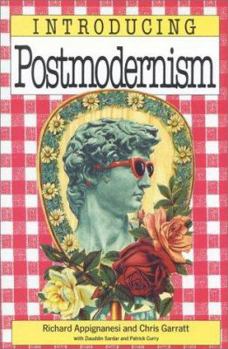Introducing Postmodernism
(Part of the Graphic Guides Series and Introducing Graphic Guides Series)
Select Format
Select Condition 
Book Overview
An enjoyable, comic-style book on this enigmatic concept that has defined our cultural condition over the past twenty years. This description may be from another edition of this product.
Format:Paperback
Language:English
ISBN:1874166218
ISBN13:9781874166214
Release Date:July 1995
Publisher:Icon Books Company
Length:173 Pages
Weight:0.49 lbs.
Dimensions:1.0" x 6.0" x 9.0"
Customer Reviews
5 ratings
Far from ideal, but still has its use
Published by Thriftbooks.com User , 15 years ago
Let me first note that this review isn't for the print book but rather for the 2-hour audio presentation, which is a very different animal. Instead of just narrating the book, the presentation uses actors playing characters, sound effects, music samples, and interviews. In other words, the presentation format is itself postmodern, which I imagine was quite intentional. For the most part, this unusual approach works, though a significant negative is that some of the actor's accents were so strong that I had a hard time understanding them. The presentation starts with postmodern art, which I think was a mistake, since both art and postmodernism are each seperately plenty amorphous, so trying to combine them makes it doubly hard to clarify what postmodernism is. As a result, my evaluation of this presentation had dropped to 3 stars at the half-hour mark, and was flirting with 2 stars by the one-hour mark. But things started to improve after that, as much of the fog cleared during the second hour, so I was able to (barely) give 4 stars by the time I reached the end. However, 1 star is a bonus for the creative presentation, leaving only 3 stars if one were to judge this presentation based solely on clarity in introducing postmodernism. Personally, my sense is that the hallmark of postmodernism is a foundationless and dynamic pluralism in ways of knowing, ideas and worldviews, and forms of expression (artistic or otherwise - or maybe everything is artistic?). This is why it's so hard to pin down what postmodernism "is." The whole point is that postmodernism is the name for a situation in which there's no single prevailing worldview (or "meta-narrative"), rather than being a worldview itself. Some positive aspects of this situation are that we have diverse and ever-changing menus to choose from, we can express individuality by mixing ingredients with more freedom, and we generally open new vistas for creativity and enriching experiences in all spheres of life (arts, humanities, science, theology, etc.). This might even enable genuine progress in some arenas (eg, science, technology, and social organization), which is somewhat ironic since many consider the idea of progress to be contrary to the ethos of postmodernism. But some negative aspects are that building consensus can be very difficult (even with respect to basic values and standards), we may be too quick to disregard worthy traditions and important lessons from the past, and groundlessness and instability can be fragmenting and disorienting, potentially to the extent that we run the risk of altogether losing our grip on reality. In that regard, to those hyperintellectuals who assert that the virtual and real are blurred together, let me just bluntly point out the significant difference between virtual death (eg, in a video game) versus real death (eg, losing a loved one). Let's please remember that inability to firmly pin down reality doesn't mean there is no (objective) reality.
clear introduction to a confusing topic
Published by Thriftbooks.com User , 17 years ago
Introducing Postmodernism is a basic introduction to Postmodern thought. As it is a basic introduction, it does not go very far into depth on any one aspect of Postmodern thought. Still, it clearly represents the main aspects of Postmodernism namely, legitimization, reproducibility and hyper reality. Before reading this book I had no idea what Postmodernism was, now at least I have some idea. The book includes a useful list of books for further reading at the end. Also, you can read about some of the main thinkers in other totem books for example Introducing Derrida.
Introducing A Book Review
Published by Thriftbooks.com User , 20 years ago
The book is the best short treatment of recent intellectual currents in western thought that I have read. It is especially applicable to the U.S. in the quotation: "The crux of postmodernity is that there are two 'presents'." One is a 'spectre' present, a Virtual Reality techno-media simulacrum that makes the other 'real' present appear borderline, fugitive, elusive." T.R. Cattan
Post Modernism Explained For the Rest of Us...
Published by Thriftbooks.com User , 24 years ago
I really enjoyed the unique approach that this book took towards explaining post modernism in a straight forward non-academic manner. The book reads like Mad Magazine does Post Modernism. It is illustrated throughout and you know what...It's zany, fun, and delightful.. You would have to be a real sourpuss or maybe on of those three or four people who don't like Mad magazine, the Marx Brothers, or the Three Stooges not to enjoy it.
Fun way to stumble into a challenging debate
Published by Thriftbooks.com User , 25 years ago
Enjoyable, accessible, and hard to put down for anyone who is interested in the development of the humanities in the 20th century. Unlike most books on the subject, this book recognizes the depth and often contradictory and confusing notions of what exactly it means to use the word "postmodern." I would say it's essential for those interested in philosophy, art, social theory, etc. And it's funny, entertaining, and probably most importantly, unpretentious, all without sacrificing informative depth. A sigh of relief, and a breath of fresh air for anyone who wants a stimulating and light-hearted introductory study of postmodernism.






